Eight ways indoor plants can improve your home
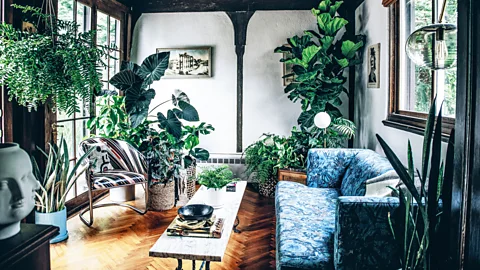 Hilton Carter/ CICO Books
Hilton Carter/ CICO BooksFrom tiny terrariums to tiger-print statements, houseplants can enhance any interior. Dominic Lutyens asks "plantfluencers" for their top tips and tricks.
In homes across the world, particularly in Millennial and Gen-Z households, a trend for houseplants is flourishing. Gone are the days when a solitary yukka plant or kentia palm occupied a corner of a living room. Now a profusion of plants and a much bigger variety of species fill homes to luxuriant and exotic effect – from the classic monstera deliciosa, commonly known as the Swiss cheese plant, to the sinister-sounding but decorative Neoregelia "Hannibal Lecter" with its dramatic, aubergine-on-green tiger-print pattern and prickly leaves. Houseplants are assuming as much importance as pieces of furniture in a room, and today's plant propagators are not only increasingly horticulturally savvy but also know how best to pot plants and maintain them to ensure they thrive.
More like this:
The craze harks back to 1970s homes – the revival of the retro macramé hanging plantholder is a bit of a giveaway. The 70s loved Victoriana, and the houseplant boom is a throwback to that era as well. And the widespread environmentalist adoption of biophilic design and architecture – which highlights greenery, water, fresh air and natural materials and forms in interiors – is fuelling this phenomenon.
"Social media is boosting the boom, with people who love plants sharing pictures of them everywhere," says Hilton Carter, US-based "plantfluencer" (a horticultural influencer) and author of new book Living Wild.
"The fascination with houseplants stems from people wanting to reconnect with nature," says Emma Sibley, founder of the shop London Terrariums, which holds workshops teaching how to make terrariums – another facet of the trend. "Throughout lockdowns, people were glued to their screens while working from home, unable to be in nature."
Houseplants satisfy people's nurturing qualities, she tells BBC Culture: "They've introduced a ritual into the day that disconnects people from screentime and allows them to look after something that needs them." We spoke to several plantfluencers to discover eight of the latest trends in styling houseplants.
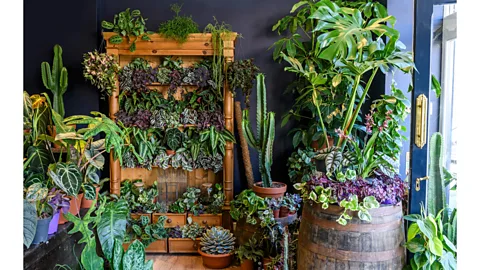 Dorling Kindersley/ Jason Ingram
Dorling Kindersley/ Jason Ingram1 Colourful plants
According to Tony Le-Britton, author of new book Not Another Jungle – also the name of his plant shop in Northampton, UK, and his Instagram account – variegated plants (plants with leaves of two or more colours) are one of the biggest trends now. Available in an ever-expanding selection of colours and patterns, these can be teamed with practically any room's colour scheme. "Just as tulips were bred in the Netherlands in the 1600s, so the Dutch government has seized the opportunity to breed new variegations in plants," he tells BBC Culture. "Demand for houseplants skyrocketed during lockdowns. Once the houseplant bug bites, you want to find out what else is available. People searched online for more unusual plants, which originally only serious plant collectors took an interest in. The diversity of plants is constantly increasing. While white-and-green variegation is still common, there are also many variations of reds, pinks and oranges. People are now deliberately buying plants they can work into a room's colour scheme, matching them with paint colours and patterns found in upholstery."
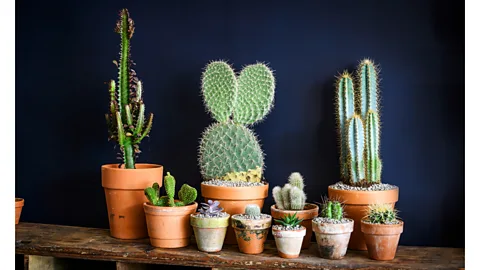 Dorling Kindersley/ Jason Ingram
Dorling Kindersley/ Jason Ingram2 Dark walls make plants stand out
One of Le-Britton's favourite styling tips is to display a wide variety of plants against walls in dark, matt colours, such as midnight blue or forest green, which makes the plants’ different forms and textures stand out more, and their colours appear more vibrant. These might include the characterful monstera deliciosa, sometimes called split-leaf philodendron, a plant with lusciously glossy "fenestrated" leaves (the botanical term for perforated leaves). "This was very popular in the 1970s, and has made a massive comeback," he says. "Today their leaves crop up time and again as motifs on wallpapers and furnishing fabrics." Le-Britton also favours begonia maculata, whose leaves have polka dot-like spots and a vibrant red underside. For more colour, he includes the versatile purple-leaved Tradescantia – it also includes climbing and trailing species.
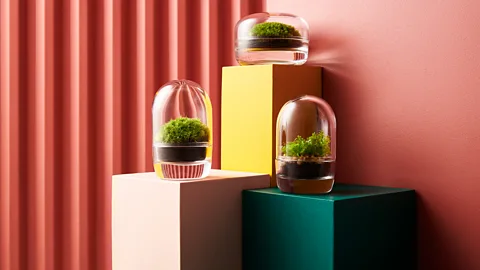 London Terrariums
London Terrariums3 Terrariums and mossariums
One sub-trend of the houseplant phenomenon is terrariums, which appeal for being low-maintenance, eye-catching and aesthetically pleasing. According to Sibley, "Sometimes an overpopulation of houseplants causes people to panic about how to look after them all. That's where a terrarium – the perfect fusion of houseplant and ornament – comes in. Terrariums require little care and can be left for months at a time without the need to intervene. This appeals to those who travel a lot and need friends and family to water their plants." There's now even a trend for mossariums – terrariums containing moss, she says. Moss, incidentally, is much in demand. "People seem to be gravitating towards an all-green moss trend, which gives a really fresh feel to a space."
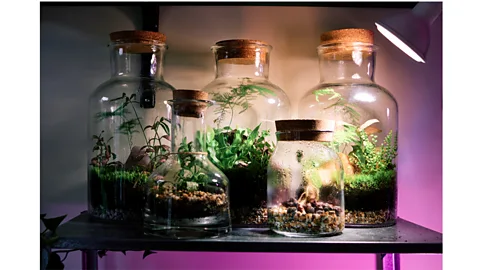 Getty Images
Getty Images4 Illumination of plants
One recent houseplant trend has seen the broadening of options for lighting indoor plants, which is not only practical but can result in pleasingly atmospheric effects. Plants need natural light to flourish but in some spaces, such as darker corners, this is in short supply. One big trend now is for grow lightbulbs, which compensate for natural daylight and trigger photosynthesis. These are available from lighting shops and online retailers, and can be used in normal light fittings, allowing plants to be placed anywhere. Terrariums can be fitted with grow lights, too. "Terrariums appeal for conjuring up miniature worlds that people can mentally escape into, and illuminating them enhances their magical quality," says Le-Britton. "Another recent trend is for a lamp-terrarium hybrid. This is a lamp with a bulbous glass base that doubles as a terrarium and is lit by the lamp's lightbulb. A recent post about this idea went viral on Instagram, and the idea has caught on globally."
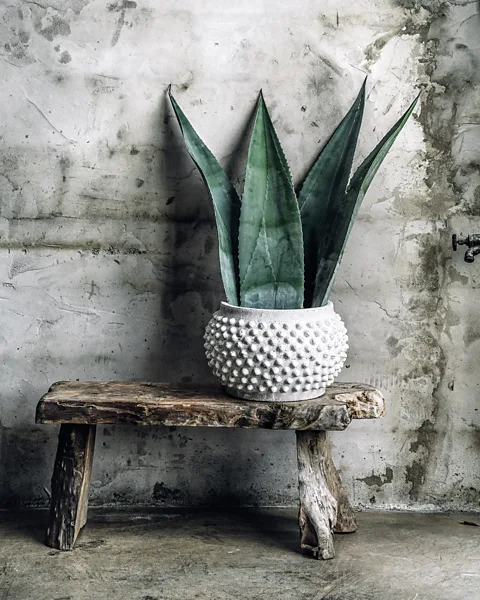 Hilton Carter/ CICO Books
Hilton Carter/ CICO Books5 Imaginative planters
As the repertoire of houseplants expands in many homes, so we're witnessing a far greater choice of plant holders to contain them. But this operates on two levels – aesthetic and practical. With plantfluencers and houseplant enthusiasts increasingly aware and appreciative of the sheer variety of plants they can grow, they are also becoming more discerning about choosing a good-looking, stylish planter. Hilton Carter discusses this trend in detail in his book, but isn't prescriptive when it comes to aesthetics. He favours planters that are unusual or characterful in a variety of styles, from simple white ceramic planters with a fluted surface at the more minimal end of the scale to suitably organic clay containers made using the Japanese pottery technique of nerikomi, whereby thin layers of clay, often in subtly different earthy tones, are stacked and then manipulated to create a marble effect. However, plants only thrive in plant holders made of certain materials: cacti, for example, require porous containers made of concrete, clay or terracotta so the soil can dry out quickly after watering. Other plants, such as the tropical Peperomia, are happier in glazed ceramic or metal planters that retain moisture.
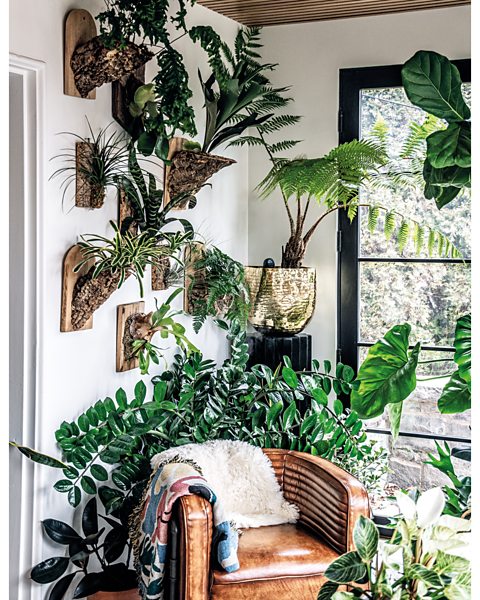
6 Living walls and plants roaming free
With styling of houseplants becoming ever more adventurous, it's not surprising to learn that one trend is for houseplants to appear to escape the confines of a pot or planter and roam free. If plants have traditionally climbed external walls of buildings, there's no reason why they can't climb internal walls or trail along mantelpieces. The idea of plants and trees growing on the walls of buildings, made famous, for example, by Milan's Vertical Forest (two residential towers housing 800 trees and countless plants) has caught on indoors, providing a more original alternative to wallpapers and art – one dubbed "living art" by Carter. He cites two examples – firstly, plants, such as staghorn ferns, mounted on cedar boards or pieces of reclaimed wood, their roots wrapped in cork or moss, and secondly, indoor living walls, which carpet an entire wall and require irrigation systems. Both animate coldly featureless walls, he tells BBC Culture: "You're taking what is typically a flat, hard surface and making it come alive… A living wall is an art piece that is forever morphing and becoming new." Given today's widespread adoption of biophilic design, this trend looks set to endure. Since the plants in this instance are attached to walls, it's also a good space-saving solution in compact interiors.
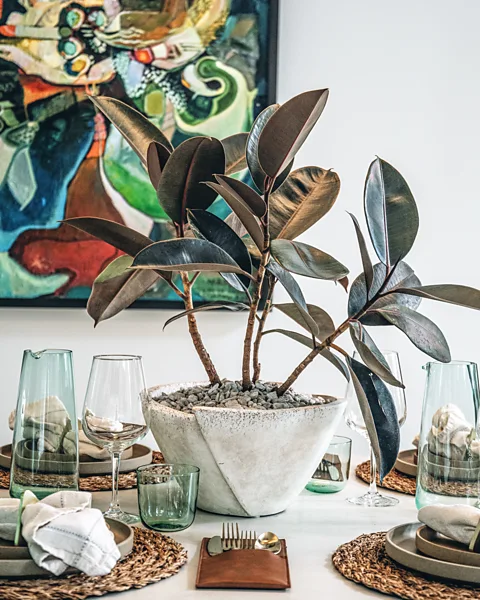 Hilton Carter/ CICO Books
Hilton Carter/ CICO Books7 Living centrepieces
With restaurants and dining tables for private parties often incorporating pots of herbs diners can pluck from, it's not surprising to hear that formal flower arrangements in vases serving as centrepieces are being supplanted by longer-lasting alternatives, such as lemon trees growing in pots. "Let's say the occasion is a summer party," suggests Carter in his book. "You could position a Meyer lemon tree in the centre of your table, and pick lemons from the tree to serve in cocktails you're serving guests. If you're having an intimate dinner with friends, styling plants that sit low on the table, like a group of succulents, will add a touch of greenery and allow conversations to flow easily without blocking anyone's view." Such ideas naturally accord with today's growing commitment to biophilic and sustainable design; cut flowers are wasteful by comparison. Another increasingly popular centrepiece option is cuttings taken from plants and placed in water. Once these sprout roots, they can be potted in soil to create new plants. "These centrepieces keep the look you are going for much longer than those featuring cut flowers," Carter points out.
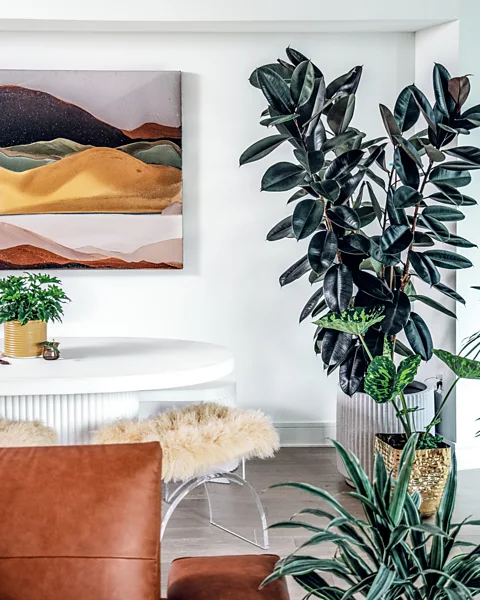 Hilton Carter/ CICO Books
Hilton Carter/ CICO Books8 The statement plant
What if a houseplant fan likes a degree of greenery around them, deeming it calming, but draws the line at the current trend for rooms that recall Victorian hothouses or even jungles? The answer could be to go with another trend highlighted by Carter: a large, eye-catching plant judiciously placed in an otherwise sparsely furnished space. A plant approximating the size of a young tree and with a simple trunk crowned by leaves can be placed at the end of a hallway, giving the space a focal point, and creating a more dramatic vanishing point. To achieve this pared-down effect, Carter recommends towering plants, such as Australian tree ferns and the large-leaved Ficus lyrata (fiddle-leaf fig). "I like styling minimalist spaces with one large pop of greenery."
Living Wild by Hilton Carter is published by CICO Books on 28 March; Not Another Jungle by Tony Le-Britton is published by DK/Penguin Random House on 11 April.
If you would like to comment on this story or anything else you have seen on BBC Culture, head over to our Facebook page or message us on Twitter.
And if you liked this story, sign up for the weekly bbc.com features newsletter, called The Essential List. A handpicked selection of stories from BBC Future, Culture, Worklife and Travel, delivered to your inbox every Friday.
